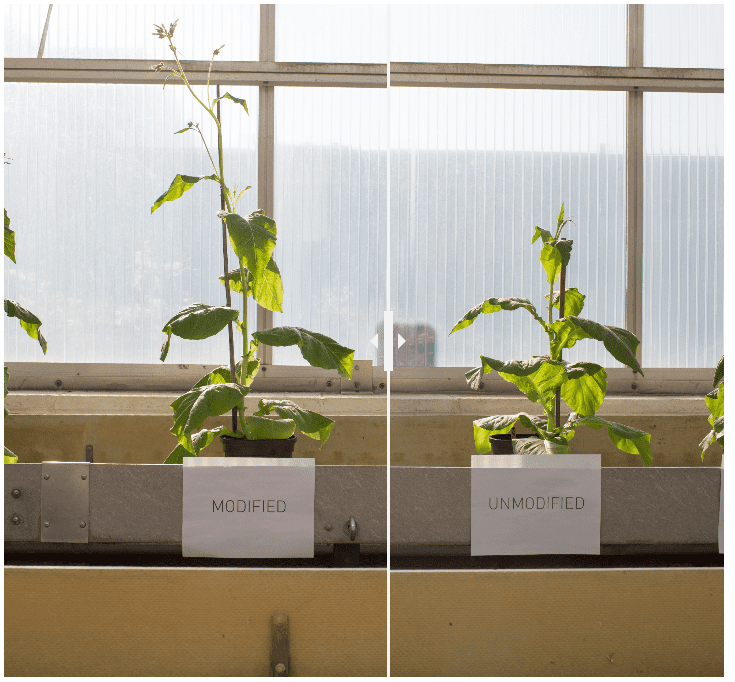
Left: Modified tobacco plant with 40% more biomass thanks to photorespiration shortuct. Right: much smaller unmodified tobacco plant. Credit: RIPE.
The world’s population is not only growing in absolute numbers, but also in its wants and needs. Rightfully so, people desire access to calorie-rich, healthy, nutritious food — but all of this puts incredible strain on our water and land resources, as well as on our carbon budget. One solution is growing more food with the same resources by engineering crops to yield more per acre. The latest contribution towards this goal involved engineering crops with a photorespiratory shortcut, which led to a 40% increase in yield in real-world conditions.
Taxing breathing
The backbone of photosynthesis — the process used by plants and other organisms to convert light energy into chemical energy — is an enzyme called Rubisco. However, the most abundant protein on Earth has been a bit too successful for its own good, having contributed to a much more oxygen-rich atmosphere compared to the time the enzyme first evolved. The immediate consequence is that Rubisco is not always able to distinguish between carbon dioxide — which it uses along with water to promote plant growth — and oxygen, which is a byproduct of photosynthesis but also toxic to plants. Plants act on oxygen instead of carbon dioxide about 20% of the time.
In order to adapt, plants have developed a process called photorespiration. For most plants, this metabolic pathway is wasteful, expending a lot of energy and interfering with photosynthesis.
“Photorespiration is anti-photosynthesis,” lead author Paul South, a research molecular biologist with the Agricultural Research Service, said in a statement. “It costs the plant precious energy and resources that it could have invested in photosynthesis to produce more growth and yield.”
South and colleagues part of the Realizing Increased Photosynthetic Efficiency (RIPE), an international research project whose mission is to engineer crops with more efficient photosynthesis, sought to simplify photorespiration in order to cut its energy use. Normally, photorespiration uses three compartments in the plant’s cell that are joined together through a complex route. To optimize the pathway, the researchers tweaked different promoters and genes, creating three alternate routes.
Over the course of two years, the research team tested these roadmaps in 1,700 plants until they found the most optimized version. The study only involved tobacco plants, a model organism in genetic studies because it is easier to engineer. The modifications can be applied to any other photosynthetic plant, nevertheless.
The researchers found that the engineered tobacco grew faster, taller, and produced 40% more biomass than unmodified plants. Unlike previous photorespiration studies, South and colleagues tested their work in the field, in real-world agronomic conditions.
It might take another decade, however, before the biotech can be applied at scale to food crops and achieves regulatory approval. Meanwhile, the researchers are performing greenhouse experiments with modified potatoes, and plan on doing similar tests with soybean and rice.
“We could feed up to 200 million additional people with the calories lost to photorespiration in the Midwestern U.S. each year,” said principal investigator Donald Ort, a professor of Plant Science and Crop Sciences at Illinois’ Carl R. Woese Institute for Genomic Biology. “Reclaiming even a portion of these calories across the world would go a long way to meeting the 21st Century’s rapidly expanding food demands—driven by population growth and more affluent high-calorie diets.”
The findings were reported in the journal Science.










